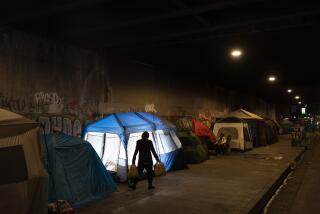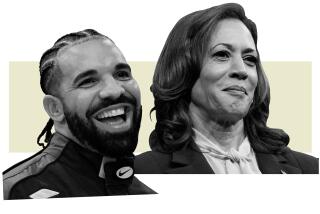COLUMN ONE : Blacks Find Bias Amid Affluence : A rapidly growing black middle class raises the prospect of a new order in civil rights and social patterns. But many say whites still do not accept or understand them.
- Share via
CHARLOTTE, N.C. — Over the last four years, David and Alfreda Belton have been working toward the American Dream.
Married in 1987, the Beltons--who together earn about $80,000 a year--now live in a spacious three-bedroom, art-laden home in one of this area’s poshest suburbs. Their 2-year-old son, Cameron, attends a private day-care facility. And they have two cars.
“I can’t complain,” David Belton says. “I want to do better in the future, but right now I’m where I want to be.”
The Beltons’ happy tale may seem like just another American success story, but there is an extra element: The Beltons are black. Although the bulk of national attention recently has focused on the underclass, the Beltons’ story illustrates that there also is a sizable black middle class and it has mushroomed.
Over the last three decades, the number of black Americans officially counted as middle class--or “affluent” in the language of the Census Bureau--has grown by almost 400%, more rapidly than any other racial category in American society. More than 1 million black households are listed by the Census Bureau as “affluent,” with incomes of $50,000 or more, and they are enjoying a middle-class lifestyle that was beyond the reach of their parents and grandparents. The figure, about 14% of the nation’s black population, is up sharply from 1967, when only 266,000 black households, or 5.8% of the total, were considered affluent.
The rapid expansion raises the possibility that the broadening of the black middle class may lead to a new order in politics, civil rights and social patterns in America. And the upscale, typical American lifestyle that middle-class status brings could alter public perceptions of all blacks as well.
“The black middle class is a kind of bellwether of black progress,” says Bart Landry, a sociologist at the University of Maryland and author of a 1987 study of black upward mobility since the 1960s. “Its very existence gives hope to blacks in other classes that they or at least their children might yet reach the American Dream.”
The gains reflect what William P. O’Hare, a social demographer at the University of Louisville’s Urban Research Institute, calls “the first fruits of the 1960s’ civil rights movement”: Civil rights laws and affirmative-action programs have dramatically broadened job prospects for young black professionals in almost every white-collar occupation. And greater educational opportunities have finally enabled young blacks to obtain the qualifications denied their parents and grandparents.
How well they have assimilated is a matter of perspective. Like the Beltons, Harold and Lillian Jackson and their three daughters, Maya, 12, Candice, 9, and Lauren, 7, are typical of the families in middle-class black neighborhoods. When they moved to Lithonia, Ga., from St. Louis four years ago, they chose their $245,000 two-story, five-bedroom Colonial in the Hunter’s Hill subdivision for the same reasons that motivate many white home buyers: “We wanted the kids to be in a good school district,” says Harold Jackson, 44, a public relations and marketing executive.
The Jacksons often entertain at home, frequently having parties to discuss books written by black authors or to dance to old rhythm-and-blues tunes blaring from the compact disc player in their family room. “This is living,” Harold Jackson boasts.
Problems Remain
Joel Garreau, a Washington-based white journalist and author who has written on the subject, contends that with the exception of skin color, many middle-class blacks already are virtually indistinguishable from middle-class whites. “The rise of a large, churchgoing, home-owning, child-rearing, back-yard-barbecueing, traffic-jam-cursing black middle class (is) remarkable only for the very ordinariness with which its members go about their classically American suburban affairs,” he argues in a recent book.
But many blacks believe that such similarities tell only part of the story, and they say life in the middle class presents some difficulties as well. Some black families find it hard to relate to white neighbors and believe that whites do not understand them or know how to accept them. Most say they encounter discrimination or racial harassment. And they are being tugged by conflicting political and social forces--whether to embrace Democratic candidates, as blacks traditionally have, or to ally with conservatives whose philosophies often appeal to upper-income suburbanites; whether to live in integrated neighborhoods or in all-black communities--that some fear force them to choose between their fast-improving lifestyles and their traditional ethnic identities.
“I’m a person in the middle,” says Vince Ford, a 41-year-old consultant who recently moved to tiny Stroudsburg, Pa., in the Pocono mountains, where his is one of only two black families living in their 120-home subdivision. Ford says he settled in Stroudsburg because it is a good place for his business, but he doubts that his colleagues and neighbors are aware of how truly isolated he feels. “The whites around me aren’t aware of my world, and I don’t believe they have a desire to know anything,” he says. “It makes me angry that they don’t want to know as much about me as I know about them.”
Even David Belton concedes that he sometimes still feels “like an immigrant” in his own hometown, struggling to fit into his suburban neighborhood. “Middle-class blacks haven’t decided whether we are more black than middle class, or is class more important than our race,” he says, recalling stem-winding debates that often occurred among his friends going back to college days.
Staying in Cities
Alvin F. Poussaint, a Harvard University psychologist, says such feelings of not belonging are common among affluent blacks who move away from friends and family to upgrade their lifestyles. Affluent blacks “feel they have some cultural differences from the white mainstream,” Poussaint says. “You can tell it by the way they (blacks) talk to each other and the music blacks prefer.”
Experts say the disparity also reflects the fact that blacks, like whites, tend to live in communities with people most like themselves. The University of Maryland’s Landry reports that his studies suggest that, although more upper-middle-class black households have begun moving into largely white suburban neighborhoods, most affluent black families have bought only in predominantly black neighborhoods attached to the central city. Census Bureau statistics show that 56% of affluent blacks live in central cities, and 40% live in the suburbs--a sharp contrast to patterns among affluent whites, 25% of whom live in central cities, with 61% in the suburbs.
But there are other reasons that blacks tend to cluster in predominantly black communities: Their income, on average, still is lower than that of whites, and they often cannot afford the higher prices of homes in mostly white neighborhoods. The jobs they hold often are downtown, making commuting less palatable. Discrimination in the suburbs also is a problem.
Kirk Fancher, a city planner who lives in an all-black, middle-class neighborhood in inner-city Baltimore, says homes in the Ashburton community are bigger and less expensive than houses in comparable all-white communities. “I looked all over the city and county,” he says. “The houses in my neighborhood cost about $80,000 to $90,000. In other places (where whites live), the same house would cost $140,000 to $150,000. It makes no sense to pay that kind of money just to live next door to a white person.”
Besides, Fancher says, even if he could afford the higher purchase prices in the suburbs, “I like the city. Hopefully, our presence in the city will have a positive influence on the city. (Black) people need to see black families living in prosperous surroundings. It says something to a kid living in utter poverty that there is some other life other than the streets and the drug trade.”
Instances of Bias
Most middle-class blacks say that neither their money nor white-collar status has insulated them from racial insensitivity or outright discrimination--from instances when they were mistaken for crime suspects to ostracism by colleagues at work. The Los Angeles Times Poll recently found that 58% of affluent blacks and 54% of colleged-educated blacks said that they had experienced job or education-related prejudice--actually higher rates than for blacks with lower incomes and no college education.
“Unlike generations of white ethnics who immigrated to the United States from Europe, blacks have not found these barriers of discrimination and residential segregation lowering as they moved up the economic ladder,” Landry says.
DeWayne Wickham, a newspaper columnist who works at home, recalls emptying his mailbox at the curb of his suburban Baltimore home when a white neighbor drove up and asked how much he would charge to cut her lawn. “I was wearing a black silk shirt, black linen trousers and black (dress) shoes standing by my mailbox with my mail in my hands, and she wanted to know if I would cut her lawn!” he says, still seething.
The incident convinced Wickham that America’s melting pot “doesn’t melt blacks,” regardless of their apparent wealth or affluence. “If a first-generation immigrant comes to this country and starts a business, he’s only an immigrant for that generation,” Wickham says. “In the second generation he’s an American. If you’re black, a 10th-generation black American, you’re still and always will be a black American. You’re not going to assimilate, because your skin color marks you as a foreigner.”
Many of today’s affluent young blacks are children of middle-class parents who have built on their middle-class foundations and achieved an even more affluent lifestyle. David Belton fondly remembers growing up during the 1960s on the west side of Charlotte in the city’s black neighborhood. On his tree-shaded street, neighbors included schoolteachers, college professors, day laborers and postal workers. They were hard working-people who inspired him to attend college and to become a college professor. His father, the principal of a segregated black elementary school, and his mother, who worked as a guidance counselor, were childhood role models.
His current lifestyle is similar, but a visible notch closer to genuine affluence. Belton is a college administrator and his wife is a department store manager.
Others were prodded by working-class or low-income relatives into earning advanced degrees. Brenda Bell-Boone, a 29-year-old pharmaceutical sales representative in Columbia, S.C., recalls that her father, a brick mason and part-time farmer who never finished high school, continually impressed upon his five children the value of a college education. Today, all of them have college degrees and one has a master’s degree in psychological social work.
“From my earliest days, I can remember how my father read two newspapers a day, which influenced my need to know more about the world around me,” Bell-Boone says. “I always wanted to do well and make him proud of me.”
Many blacks who live in predominantly white areas also complain that their white neighbors do not seem to understand that middle-class blacks sometimes are decidedly different in their tastes: Some continue to enjoy soul food, favor African art and retain a penchant for rhythm-and-blues music.
“There is a resistance on the part of whites to understanding that life (for many blacks) is not the same, is quite different from theirs,” David Belton says. “Because I live and work in a white environment, (white colleagues and neighbors) think I have assimilated--but I haven’t.” To help underscore the differences, Belton has covered his office walls with a photo of Dr. Martin Luther King Jr. and paintings by black artists Romare Bearden and Tommy Robinson.
Not surprisingly, many experts believe that the biggest cultural difference between affluent blacks and whites is the fear on the part of many blacks that their children will grow up isolated from other black children.
“I’m noticing in my work with (affluent) black children that their parents are much more interested in maintaining the connections with black children, even if it means regularly driving across town to attend church or social gatherings,” Harvard’s Poussaint says. “While these parents may want to escape the inner city and poverty in those schools, at the same time they are not willing to completely remove their children from other blacks who live in the cities.”
Baltimore newlyweds Elisse Wright and H. Jerome Briscoe are grappling with this dilemma. She wants to live in a racially integrated suburb, but he favors a predominantly black inner-city neighborhood. “It’s important for me to see a reflection of myself in my community,” says Briscoe, an assistant prosecuting attorney for the city of Baltimore. “I want to live in the city because that’s where I’m needed, and I want to make a stand to save the city.”
But Wright disagrees. “I’m willing to consider more options,” she says. “I understand the need for middle-class blacks to provide a role model and all that, but I’m not willing to be a martyr. It isn’t a big thing to me if we cross the line into a (largely white) neighborhood in the county.”
Similarly, the Beltons say they would consider moving into a black neighborhood--particularly if her parents ever moved to Charlotte. “My father wants to retire around black people,” Alfreda Belton says. “I’m all for having an extended family in that kind of comfortable environment.”
Like middle-class whites, many middle-class blacks find themselves most comfortable with their own income group. But they also feel more at home with other blacks than with whites of any income bracket. Still, Poussaint says his studies have shown that only a small minority of middle-class blacks want to dissociate themselves entirely from poorer blacks. “They recognize that as a form of self-hatred,” he says.
Poussaint asserts that today’s middle-class blacks “are a lot more sophisticated about the subtleties of racism” than their parents were and are “more willing to maintain a black identity for themselves and their children.” Such efforts often come as a surprise to whites, he says. Middle-class blacks also are not as willing to be “tokens” in mainstream America as they were when integration still was only a distant hope, he says. “They are looking for positive validation of themselves by socializing among themselves.”
Sandra Gregg, a 36-year-old public relations executive for a Washington, D.C., hospital, recalls that whites often have annoyed her by remarking in social settings that they do not consider her black because she is so much like them.
“That’s a way of diminishing a part of who I am,” Gregg says. “If they overlook that I’m black, it’s because they’re willing to accept me and not to accept other blacks. I don’t think that’s a compliment at all.”
Michael Dawson, a political scientist at the University of Michigan, says opinion polls show that a majority of black Americans--whether wealthy or poor--believe that their “fate is linked to the race as a whole” and that individual blacks cannot easily boost their status in society as long as so much of the black community is still viewed as an underclass. But Dawson speculates that may well change once the public stops thinking of blacks as predominantly poor.
Indeed, Dawson suggests that as increasing numbers of middle-class blacks move up the economic ladder--putting more distance and dollars between themselves and poorer blacks--they may begin to turn more conservative. At that point, he says, white Americans may become far more willing to view blacks as middle-class people like themselves rather than as an underclass. “The real test will come in the next generation,” he says, “when we see if an affluent black middle class influences black politics to move toward the (more conservative) mainstream. If that is to happen, it will occur first in the new black middle class.”
Most Back Democrats
Currently, the black middle class, like most black Americans, overwhelmingly supports the Democratic Party--though Republican activists, such as Housing and Urban Development Secretary Jack Kemp and Republican strategist Roger J. Stone, have argued that the GOP could successfully woo upscale blacks away from the Democrats with policies aimed at improving their economic lot--such as more-stringent open-housing laws and tougher enforcement of anti-discrimination statutes.
“If conservatives in general and the Republicans in particular are going to make any headway with (affluent) blacks, they will have to convince them that they have a program to improve the lot of all blacks,” Dawson says. “So far, there has been very little in the way of conservative programs that would suggest they can help blacks.”
As of mid-September, The Times Poll found, 43% of blacks approved of President Bush’s handling of his job--and that number differed little by income, education or type of community. What’s more, 74% of blacks said the Democratic Party best represents their values and only 14% preferred the Republican Party.
Meanwhile, David Belton says he still is struggling to climb the economic ladder, despite the advances his family has made so far. But he insists that his middle-class lifestyle has not changed his basic values, and he hopes that others do not begin to perceive or treat him any differently. “I want people to know I’m the same person I’ve ever been,” he says. “That may be difficult for some people to accept or believe. But it’s the fact of the matter.”
America’s Growing Black Middle Class
Since 167, both the number and the proportion of black families classified as “affluent”--that is, those whose household incomes are $50,000 or more-have mushroomed, signifying a dramatic expansion of the nation’s black middle class. Here are the figures for 1967 through 1989.
Number of black families with household incomes of $50,000 or more (in thousands) 1967: 266,162 ‘89: 1,030,860
Percentage of black families in America considered “affluent” 1967: 5.8% ‘89: 13.8%
Percentage of white families with household incomes of $50,000 or more 1967: 17.1% ‘89: 30.9% Source: U.S. Census Bureau
More to Read
Sign up for Essential California
The most important California stories and recommendations in your inbox every morning.
You may occasionally receive promotional content from the Los Angeles Times.













